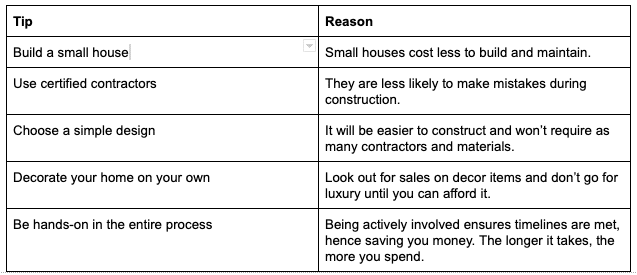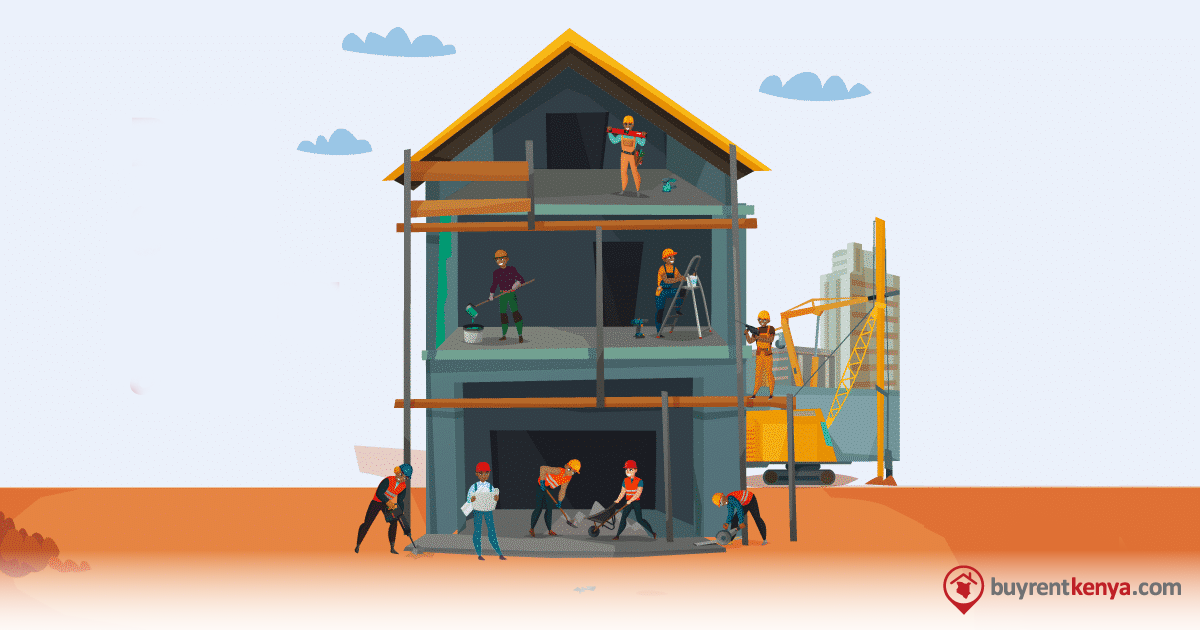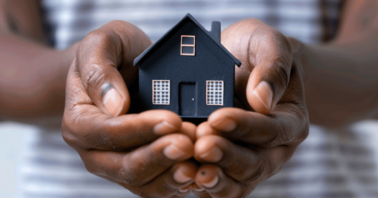For most Kenyans looking to own their own home, buying an existing house is a great option. And there are lots of choices available for purchase. But what happens when you have something specific in mind?
Building a house gives you the chance to have one that fits your exact needs and specifications. From the floor plan and design to new-customised fixtures and fittings.
However, supervising construction workers, picking supplies, getting government permits, and overall project management is not a walk in the park—especially for first-timers.
How to build a house in Kenya
Table of Contents
1. Looking for Land
If you already have the land to build on, this is perfect. But if you don’t, the first step is to decide on the location, size and how much you are willing to spend to buy the piece of land.
You could either look for land for sale online. Or, speak to a real estate agent to advise you on the area you’re considering and negotiate the best buying price.
An agent will usually charge between 1 -10% of the price of the land, which is a negotiable fee. You can either confirm from your agent or personally from the ministry of lands the following information:
- Who owns the land
- What is the zoning structure
- What permits you will require
- Whether the land has clear boundary marks
Some of the costs you will incur aside from the land price are:
- Land rate clearance certificate: Pay Kshs 10,000 to the County where the plot is located. You will get the certificate within 48 hours.
- Land maps: This is from the Lands Ministry in Ardhi House and is issued in duplicate. You will pay Kshs 300 for each.
- Ground verification: Boundary marks on the piece of land are called beacons. If they’re not present, you will pay Kshs 1,000 for each beacon.
- Legal fees: This is to ensure the land transaction is in writing. This will cost between 1-2% of the price of the land with a minimum of Kshs 35,000.
- Stamp duty: The amount you pay is based on the value of the land. It is usually 4% for urban land and 2% for rural land.
- New title deed certificate: This is the official document that shows you are the owner of the land upon completion of the transfer. The certificate costs Kshs 5,000.
2. Deciding on Your Financing
Unless you have a huge amount of money lying around, you are likely to seek financing from a bank. A construction loan is usually more difficult to get than a traditional mortgage as you are asking for money for a concept and not a physical house.
When you approach a bank to get financing, you will need an estimate of the cost to increase your chances of getting an approval. This includes detailed floor plans, budget plans and materials needed to complete construction.
READ ALSO: A Beginner’s Guide to Mortgages When Buying a House
The costs attached to the construction loan include:
- Down payment for a construction loan: between 20-25%
- Interest on loan: between 12-14%
- Home insurance: to cover the cost of reconstruction in case of a hazard like fire
- Life assurance: you will need to assure your financer that the loan payments will continue in the event of death or inability to service the loan
Some financers do offer the option of including the cost of purchasing land as part of the amount; others offer just the construction costs. Speak to at least three different loan providers and compare terms before settling on one.
After the approval, the money is released in instalments after achieving set milestones. Some banks will require you to only make interest payment during construction as opposed to a higher amount. This gives you flexibility and more time to save. Others require you to pay off the amount after completion.
You are likely to spend more than your initial budget. To cushion yourself for these miscellaneous costs, have an extra 10% over your budget to be on the safe side.
When coming up with a budget, don’t forget to factor in 16% VAT on the cost of items.
3. Deciding on the Size and House Plan
It’s easy to get carried away when building a custom home because you’ll want everything to fit your style. But there is absolutely nothing wrong with starting small then adding the extras once you’re financially able.
How do you come up with the house size and design? Here are a few things to consider:
- Number of bedrooms: an ideal house should have enough rooms per person to sleep individually plus a guest room/office. That is aside from the couple of the house.
- Number of bathrooms: at least two. One for the master bedroom and another one for the rest of the family or guests.
- House layout: if you have a baby, make sure the nursery shares a wall with your master bedroom to keep them close by. No other bedrooms should share walls for privacy. The master bedroom should be in the rear of the house, away from the street.
- House ground: the home should be surrounded by flat land. The larger the buffer between your entrance and the road/sidewalk, the better for noise and safety.
- Direction: a house facing south tends to get most of the sunlight throughout the day. Have your main rooms face east and west to get the lovely sunrise and sundown.
- Square footage: work with your architect to estimate this based on the house plan you chose.
After determining the square foot, you are in a position to determine the optimal land to building ratio; which ensures you use the land to its full potential. This is calculated by dividing the square footage of the land by the square footage of the building.
For example, if you have 200,000 square feet of land and 53,000 building square feet, this equals 3.77.
This is too high. The ideal number should be between 2.5 – 3.5. A higher ratio means you have excess land, while a smaller one means your house will be too squeezed.
Try walking around in different neighbourhoods to look at vacant houses to get inspiration. Pinterest is another site which has a variety of fantastic house plans you can replicate.
You can also take advantage of free planning apps like Planner5D to help visualise your home before beginning the construction process.
If you are planning to change homes at some point, consider its future desirability when coming up with the design. For example, having an extra bedroom to serve a growing family.
Evidently, your design will have an impact on your overall cost. The more elaborate, the more money you spend. It’s ideal to keep in mind your budget and the size of your land when coming up with the design.
4. Hiring the Right Professionals
We know it’s tempting to take on the project of building a house by yourself in the hopes of saving money. But let’s face it. You probably don’t have any construction experience, and it’s easy to make costly mistakes which could take years to recover from.
Having the right people by your side throughout the construction process will ensure that your house is structurally sound and safe to live in.
These are the essential professionals you need on your team.
Architect
This is the person to bring your vision to life. An architect usually charges 6% of the construction costs, with their main role being to:
- Create a detailed drawing of the house plan
- Specify requirements and cost estimates
- Ensure compliance with the safety and building regulations
- Assist in getting financing from the bank.
- Suggest or choose subcontractors.
- Make site visits to check on progress
Ensure that the architect you hire is licensed and registered by the Board of Registration of Architects & Quantity Surveyors (BORAQs).
Quantity Surveyor
Another key player – the money guy. He ensures you’re working within the budget. You will pay 3-4% of the total construction costs. They are in charge of:
- Preparing the bill of quantities; a document providing specific timelines, measured materials and labour for the entire project
- Providing cost estimates for the project
- Managing costs and staying within budget
- Dealing with contracts and legal matters
- Breaking down the project into smaller components
- Arranging for subcontractors’ payments
Same as the Architect, he/she should be registered by BORAQs.
Electrical Engineer
Essentially, their role is to install services such as plumbing and wiring in your next home. They charge a fee of 2% of the total construction costs. Some of their tasks are:
- Ensure all the electrical codes are met
- Design, test and install electrical systems
- Resolve electrical problems that may arise on site
- Help in designing cost estimates of labour and materials
- Design the air and plumbing systems
- Ensure proper maintenance of equipment on site
Ensure that whoever you hire is a registered member of the Engineers Board of Kenya.
Construction Engineer
The overseer – the person in charge of the entire project and is responsible for the safety of workers during construction. Apart from this, they will:
- Inspect the drawing and design to ensure that the project is feasible
- Hire subcontractors, get tools and machines for construction
- Supervise the subcontractors
- Work with the quantity surveyor to order materials and stay within budget
Their fee is 2% of the construction costs. They should also be registered members of the Engineers Board of Kenya.
Interior Designer
To save on costs, you just might end up moving with the current items you have to your new home. This means you won’t necessarily need an interior designer.
But if you want an upgrade, start by looking up furniture ideas, colour schemes, lighting, mirrors and wallpaper. Explore these helpful home decor ideas to start you off.
Additionally, there is a need to find a balance between buying decorative pieces and ones that are practical. Each item in the room should speak to the other to create synergy and fit together like a puzzle.
5. Building the House
Now that you have the right team by your side, it’s not time to sit back with no clue of how things are going. You still have to have a hands-on approach and keep them in check to follow your timelines and budgets.
READ ALSO: A Beginner’s Guide to Building a House
The team of professionals you hire will subcontract workers paid from their own fees to speed up the process. The average construction time could average between seven to twelve months depending on the house size, plan and number of workers.>
The construction stages include:
- Land preparation: Clearing out debris and vegetation and performing soil tests. This will take one to two weeks, depending on the size of land and how extensive the vegetation is.
- Laying the foundation: Excavation of the foundation and pouring of concrete to support steel rods. This will typically take between two to five weeks.
- Framing the structure: This is done using wood. Additionally, you need a house wrap to prevent the house from getting moisture and damages from harsh weather conditions. The timelines for this will depend on the size and design of your home. This could take about eight to ten weeks.
- Plumbing and electrical: After the house has dried up, electrical wiring, pipes, heating and cooling systems are installed. This could both be done in three weeks.
- Roofing: Selecting the roofing design and material will depend on your budget and how long it will last. The developer can advise you on the best option to pick. This will range from one to two weeks.
- Interior and exterior finishes: Installing doors, windows, kitchen counters, cabinets and work on any exterior fittings. This could take one to two weeks.
- Flooring: Type of flooring you settle on will depend on the cost of material and how easy it is to maintain. Some of the types include hardwood, vinyl, ceramic tile, terrazzo, carpet flooring and laminate flooring. These will take any time between one to two weeks.
- Decorating: Can be done using the pieces you already have in your current house. Alternatively, you can upgrade with new pieces to fit your brand new house. Depending on the complexity of your decor, this could take between one day to two weeks.
READ ALSO: 10 Low-Cost Construction Materials in Kenya for 2023
We’ve Equipped You with the Right Information
Now it’s your turn to bring your vision to life. Building a house is a huge financial investment, but these simple tips will go a long way towards helping you save money in the long run.

READ ALSO: Construction Laws Kenya: 6 Things You Should Know



